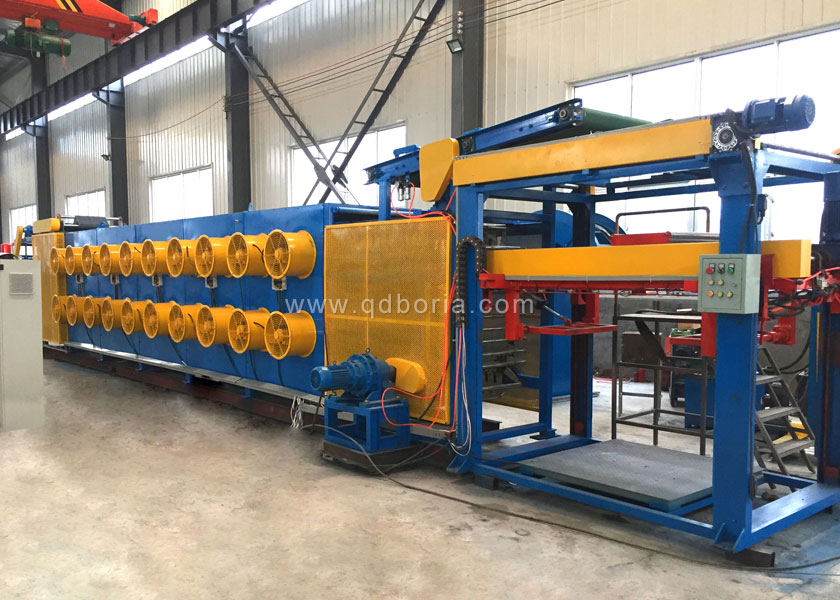
In the realm of industrial manufacturing, particularly in the production of rubber and plastics, the festoon batch-off cooling line plays a crucial role in enhancing efficiency and product quality. This system is designed to cool and prepare extruded materials before they undergo further processing. This article delves into the functionality, components, advantages, and operational considerations of festoon batch-off cooling lines.
Understanding the Festoon Batch-Off Cooling Line
A festoon batch-off cooling line consists of a series of interconnected components that facilitate the rapid cooling of extruded products. festoon batch-off cooling lin used in the rubber and polymer industries, this system allows manufacturers to achieve optimal cooling rates for various materials. The term “festoon” refers to the looping or hanging arrangement of the product as it moves through the cooling line, enabling efficient heat transfer and cooling.
The process begins as freshly extruded material exits the extrusion machine. The product is then guided through a series of cooling baths, often filled with water or other cooling fluids. The festoon design allows for a longer cooling path in a compact space, maximizing the surface area for heat exchange while minimizing the footprint of the equipment.
Key Components of a Festoon Batch-Off Cooling Line
- Extruder: The starting point where raw materials are processed and formed into extruded products. The temperature and consistency of the extrusion significantly influence the efficiency of the cooling line.
- Cooling Tanks: These are the main cooling chambers where the extruded material is submerged. Depending on the material and production requirements, these tanks can contain water, oil, or other cooling fluids.
- Conveyor System: As the material cools, it is transported along the festoon line via a conveyor system. The design of the conveyor allows the product to move smoothly and consistently through the cooling process.
- Control System: Modern festoon batch-off cooling lines are equipped with advanced control systems that monitor temperature, flow rates, and other parameters, ensuring that the cooling process is optimized for each batch of material.
- Cutting Equipment: Once the material has cooled sufficiently, cutting equipment is employed to slice the product into manageable lengths or shapes, readying it for subsequent processes.
Advantages of Festoon Batch-Off Cooling Lines
The festoon batch-off cooling line offers several significant advantages that contribute to its popularity in manufacturing:
- Space Efficiency: The festoon design allows for a compact arrangement, making it ideal for facilities with limited floor space. The vertical arrangement of the material helps maximize the cooling surface area without requiring extensive horizontal space.
- Improved Cooling Rates: The combination of submerged cooling tanks and the festoon arrangement enhances heat transfer efficiency, leading to quicker cooling times. This results in reduced cycle times and increased overall productivity.
- Consistent Product Quality: By maintaining precise control over the cooling process, manufacturers can achieve uniform cooling across all products. This consistency is crucial for meeting quality standards and reducing defects in the final product.
- Flexibility: Festoon batch-off cooling lines can be adapted to accommodate various materials and product shapes, making them versatile for different manufacturing processes.
- Energy Efficiency: Advanced control systems optimize energy consumption during the cooling process, contributing to lower operational costs and a reduced environmental impact.
Operational Considerations
While festoon batch-off cooling lines offer numerous benefits, there are also operational considerations that manufacturers must address:
- Maintenance Requirements: Regular maintenance of cooling tanks, conveyors, and control systems is essential to ensure the reliability and efficiency of the cooling line. This includes cleaning, inspections, and potential component replacements.
- Temperature Control: Maintaining the correct temperature throughout the cooling process is critical. Manufacturers must monitor and adjust cooling fluid temperatures to accommodate varying ambient conditions and material characteristics.
- Material Compatibility: The choice of cooling fluid and system design must be compatible with the materials being processed. Incompatible fluids can lead to contamination or adverse chemical reactions.
- Production Variability: Fluctuations in production volume or material type may require adjustments to the cooling line configuration or operational parameters to maintain efficiency and product quality.
- Safety Considerations: Manufacturers should implement safety protocols to protect workers handling hot materials and cooling fluids. Adequate training and safety equipment are essential to prevent accidents and injuries.
Conclusion
The festoon batch-off cooling line is an integral part of modern manufacturing processes in the rubber and plastics industries. Its efficient design, coupled with the ability to deliver consistent cooling, plays a pivotal role in ensuring high-quality products while maximizing productivity. By understanding the components, advantages, and operational considerations, manufacturers can effectively integrate this technology into their production lines, leading to improved outcomes and competitive advantages in the market.